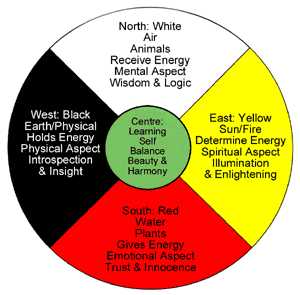Ways of Knowing - Introduction to 'Worldview' from an Historic Perspective
Ways of Knowing
 Worldviews are closely connected to ways of knowing. How Indigenous peoples come to know and understand the world around them creates a body of knowledge that is expressed in science, political systems, economic systems, and artistic expression such as drumming, dancing, writing, or other storytelling (storytelling can include pictographs, petroglyphs, wampum belts, crested blankets, totem poles, winter counts, or the sides of a painted tipi). There are many nations and therefore many worldviews. There are, however, some common themes that run across most Indigenous worldviews, characterized by the concept of the circle, interconnectedness, connection to place, and the four Rs (respect, reciprocity, responsibility, and relationships). Indigenous worldviews are also characterized by a belief in the power of creating harmony: by creating a positive shared mind with all of creation and honouring one’s connection to all other sacred beings within creation, one creates “power with,” as opposed to “power over.” The four Rs are honoured daily through experiential interactions with the cosmos, the environment, and other people. Through empathy, compassion, and kinship, Indigenous peoples believe that it is possible to create a harmonious world. Elders say that words and thoughts have the power to create and change the world.
Worldviews are closely connected to ways of knowing. How Indigenous peoples come to know and understand the world around them creates a body of knowledge that is expressed in science, political systems, economic systems, and artistic expression such as drumming, dancing, writing, or other storytelling (storytelling can include pictographs, petroglyphs, wampum belts, crested blankets, totem poles, winter counts, or the sides of a painted tipi). There are many nations and therefore many worldviews. There are, however, some common themes that run across most Indigenous worldviews, characterized by the concept of the circle, interconnectedness, connection to place, and the four Rs (respect, reciprocity, responsibility, and relationships). Indigenous worldviews are also characterized by a belief in the power of creating harmony: by creating a positive shared mind with all of creation and honouring one’s connection to all other sacred beings within creation, one creates “power with,” as opposed to “power over.” The four Rs are honoured daily through experiential interactions with the cosmos, the environment, and other people. Through empathy, compassion, and kinship, Indigenous peoples believe that it is possible to create a harmonious world. Elders say that words and thoughts have the power to create and change the world.
Language reflects worldview. Most Aboriginal languages focus on action and transformation (Cree uses more verbs than nouns), relationship, and more than one way of understanding. For Aboriginal peoples, there may be multiple realities. There is no such thing as absolute truth; all truth is relative to a particular context, and reality is represented in the relationship one has with truth. Thus, an object or thing is not as important as one’s relationships to it. Reality is represented in relationships, which means that reality is not a static state – it is a process, and this process will be different for each person.
Indigenous learning addresses the whole person, encompassing the mental, physical, spiritual, and emotional capabilities of that person in relation to all living thi

ngs. This unified vision is in contrast to the European focus on an analytic approach, and the fragmentation of concepts within discrete disciplines. For Indigenous peoples, analysis is cumulative, collaborative, and circular. These ways of knowing are reflected in Indigenous worldviews, which emphasize connectivity, relationality, and interrelatedness.
First Nations people believe that humans take multiple trips around the medicine wheel; this spiral learning starts with gaining knowledge, continues with using reason, engaging in deep thought, and, finally, being rewarded with insight. But each journey around the wheel reveals deeper, different truths. Life is about constant transformation and greater self-awareness. Thus, within the interrelatedness of Aboriginal worldviews lies a deep and abiding freedom of the individual.Used with permission from Suzanne Methot, Dragonfly Consulting Services Canada, http://dragonflycanada.ca/resources/aboriginal-worldviews/